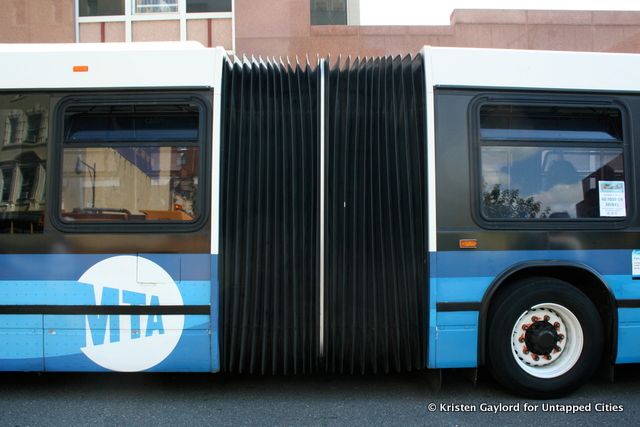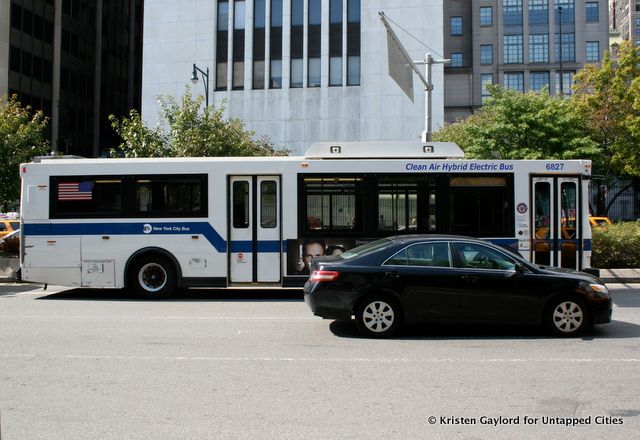Last-Minute NYC Holiday Gift Guide 🎁
We’ve created a holiday gift guide with presents for the intrepid New Yorker that should arrive just in time—


 Transit historian Edward R. Crew, a former subway conductor, at the “Historians Depot.”
Transit historian Edward R. Crew, a former subway conductor, at the “Historians Depot.”
On Sunday the New York Transit Museum took part in the ten-block Brooklyn street festival called Atlantic Antic, putting on its 19th Annual Bus Festival. The morning was bright and sunny, and Boerum Place between Atlantic Avenue and Livingston Street was lined with vintage buses and other surface vehicles. And by every one were fascinated children, reminiscing parents, and transit experts ready to answer every question.
And now, just a sampling of our city’s storied relationship with wheeled public transit.
Yellow Coach Company, model Z-BH-602 (1931-47)
In the 1930s, this was one of 100 double-decker buses operated by Fifth Avenue Coach along Fifth Avenue. Similar buses were utilized in other urban centers such as Philadelphia, Chicago, and St. Louis.

General Motor Corporations, model 5101 (1949-66)
This model, designed specifically for New York City as one of the first 40-foot long models, featured a “double-wide” front door. Those doors still look pretty narrow by today’s standards”¦


The bus ran in four boroughs for over fifteen years, operated by NYCT. The Transit Museum model was re-numbered (2969) to match the bus in the television series The Honeymooners.

General Motors Corporation, model 5301 (1962-82)
When I boarded this bus, I heard sighs of nostalgia from New Yorkers remembering the two decades it ran in Queens, from 1962-82.

I, along with all the kids, couldn’t get over the shiny sea foam green interior–including green lighting–and plastic seats and ceiling.

General Motors Corporation, model 5303 (1966-90)
While keeping with the sea foam green, this bus was the first run in New York City with air-conditioning. (Say a prayer of thanks!) It was ordered when NYCTA took over lines from Fifth Avenue Coach in 1962.


They were reliable buses, and operated in Manhattan and the Bronx for 24 years, complete with great advertising space.


Grumman Corporation, model 870 (1980-84)
This “Advanced Design” bus integrated technological advancements that we now take for granted in city buses, including wheelchair lifts and electronic destination alerts. Unfortunately, it also housed serious structural flaws, and the entire fleet was retired in 1984.



General Motors of Canada, Ltd., model T8H-5308A (1982-2005)
In 1970 the New York Bus Service began running commuter service between Manhattan and the Bronx. This bus from 1982 was made with its suburban passengers in mind: forward-facing seats, baggage racks, and reading lights. New York Bus Service was independent until the MTA incorporated it in 2005 under MTA Bus Company, which is consolidating seven previously private bus companies in the city.


Novabus, model LFS T-Drive Artic (2010-present)
And then, the only bus at the festival to be introduced in New York while I have been alive! The three-door articulated bus, or “accordion bus,” is lower, has more doors, and zips up and down Second Avenue, among other places, operating as Select Bus Service. If you haven’t tried SBS, I recommend it: it gives a glimpse of what buses could be in New York City with off-board fare collection and dedicated lanes, pioneered in Bus Rapid Transit systems.

As I left and walked to the subway station, I passed a bus “in the wild.” Not very glamorous, to be sure, but a necessary and integral part of this city’s movement. And with improvements like SBS and BusTime, the MTA and NYCT are keeping NYC’s public transit moving apace with its people. Which is saying something.

Get in touch with the author at @kaygegay.
Subscribe to our newsletter